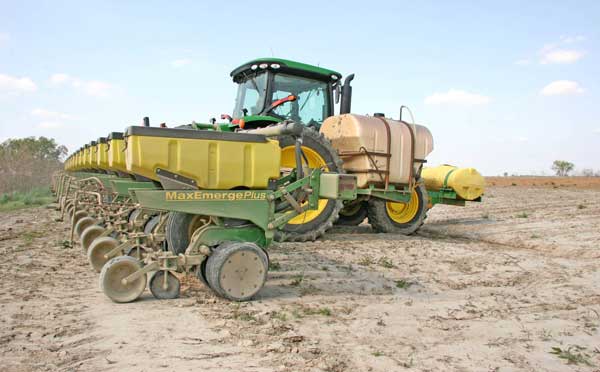
Cotton acres in the Rio Grande Valley are increasing in mid-April, but, thanks to the drought and continuing water issues, current acreage represents only a percentage of historical planted acres.
The Valley represents the state’s earliest planted and harvested cotton each year. According to estimates from the Boll Weevil Eradication Foundation, about 63,000 acres had been planted by the end of the first week of April, but a push for last minute planting may push that number closer to 70,000 by the end of the month.
“It’s going to be a strange sight this year driving down the road and seeing fields where nothing was planted and nothing is growing,” reports Hidalgo County Extension agent Brad Cowan.
Many growers with a history of planting cotton waited as long as they could before federal crop insurance deadlines, but “many didn’t plant at all.
“A lack of rain and the prospect for continuing drought has everyone on edge. We’re past planting deadline for cotton and what we have now may or may not produce well,” he said.
No one knows for certain how many of the planted acres are dryland cotton and how many represent irrigated acres of cotton, but regardless, the total number of acres falls far short of last year’s 145,000 acres of total cotton. Even that figure falls short of historical numbers of cotton acres in the Valley region.
If you are enjoying reading this article, please check out Southwest Farm Press Daily and receive the latest news right to your inbox.
Cotton is historically planted in the Valley in February and March and annual acreage fluctuated between 200,000 to 350,000 acres a decade ago. About 65 percent of those acres were irrigated and the remainder was dryland cotton. But in recent years trending dry conditions have contributed to a decline in cotton acres, and last year many farmers favored planting grain sorghum, a more drought-tolerant crop, over cotton.
So far this year no one seems to know the number of sorghum acres planted, but Cowan says the grain planted so far this year is also suffering from dry, windy conditions.
“A lot of sorghum fields are pretty stressed. If we don’t get substantial rain this growing season, we’re going to see a lot of failed crops,” he said.
But Cowan says some of the Valley cotton, “looks pretty good so far,” both irrigated and dryland acres. He indicated it was “hit or miss” in terms of acreage that would end with a favorable harvest and what would not. But a lack of growth in many fields is the “stark reality of the moment,” an unusual sight in a region that is usually green with production crops this time of year.
John Norman, editor of the Valley’s Pest Cast, a Texas AgriLife IPM newsletter, says cool nights and warm, sunny afternoons in the Valley the last few weeks has contributed to plant stress and forced plants to mature more slowly. It can also make plants more prone to insect damage, he says. The majority of cotton planted in northern and western reaches of the Valley is at seedling stage, or four to five true-leaf stage. Some cotton planted in February has six-to-nine true leaves and has started to square. Dryland producers in Willacy County and parts of Cameron County, however, have yet to see cotton come up.
A few reports of red spider mite populations and aphids are beginning to show up in some fields. In Cameron County, a few farmers have been spraying for thrips, according to Norman. He advises growers to check fields often for damage, especially on two true-leaf cotton. The Valley is also still troubled by boll weevils, but so far traps have not indicated serious risks this year.
Corn planted in the Valley, like sorghum, shows signs of twisting leaves, an indication of heat stress, but, by contrast, some reports say grain sorghum in parts of the Valley is already heading nicely and some corn is tasselling out and maturing on schedule.
Norman reports some corn growers have reported beet armyworms and a few have seen bollworms, but no harmful numbers have been reported so far.
You may also like:
Drought leaves 2013 growing season vulnerable
Valley farmers planting, but drought and wind cause early damage
Wheat freeze damage provides opportunity to rotate to cotton
About the Author(s)
You May Also Like




